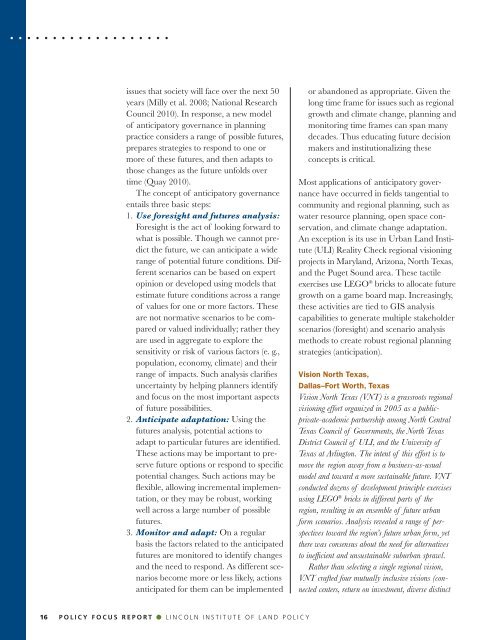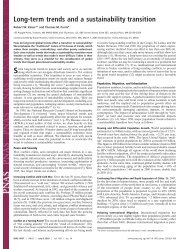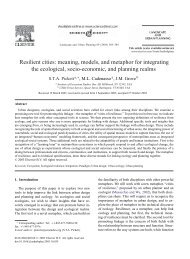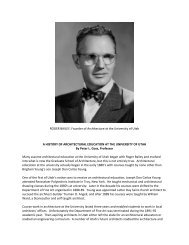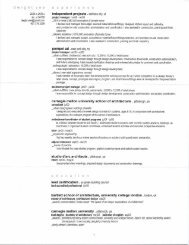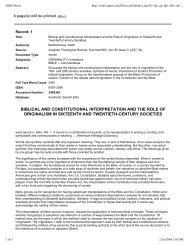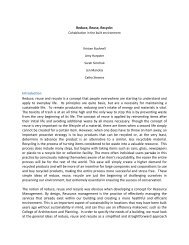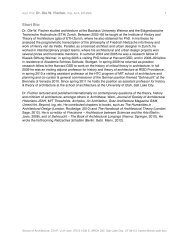Opening Access to Scenario Planning Tools - Knight Foundation ...
Opening Access to Scenario Planning Tools - Knight Foundation ...
Opening Access to Scenario Planning Tools - Knight Foundation ...
You also want an ePaper? Increase the reach of your titles
YUMPU automatically turns print PDFs into web optimized ePapers that Google loves.
. . . . . . . . . . . . . . . . . . .<br />
issues that society will face over the next 50<br />
years (Milly et al. 2008; National Research<br />
Council 2010). In response, a new model<br />
of anticipa<strong>to</strong>ry governance in planning<br />
practice considers a range of possible futures,<br />
prepares strategies <strong>to</strong> respond <strong>to</strong> one or<br />
more of these futures, and then adapts <strong>to</strong><br />
those changes as the future unfolds over<br />
time (Quay 2010).<br />
The concept of anticipa<strong>to</strong>ry governance<br />
entails three basic steps:<br />
1. Use foresight and futures analysis:<br />
Foresight is the act of looking forward <strong>to</strong><br />
what is possible. Though we cannot predict<br />
the future, we can anticipate a wide<br />
range of potential future conditions. Different<br />
scenarios can be based on expert<br />
opinion or developed using models that<br />
estimate future conditions across a range<br />
of values for one or more fac<strong>to</strong>rs. These<br />
are not normative scenarios <strong>to</strong> be compared<br />
or valued individually; rather they<br />
are used in aggregate <strong>to</strong> explore the<br />
sensitivity or risk of various fac<strong>to</strong>rs (e. g.,<br />
population, economy, climate) and their<br />
range of impacts. Such analysis clarifies<br />
uncertainty by helping planners identify<br />
and focus on the most important aspects<br />
of future possibilities.<br />
2. Anticipate adaptation: Using the<br />
futures analysis, potential actions <strong>to</strong><br />
adapt <strong>to</strong> particular futures are identified.<br />
These actions may be important <strong>to</strong> preserve<br />
future options or respond <strong>to</strong> specific<br />
potential changes. Such actions may be<br />
flexible, allowing incremental implementation,<br />
or they may be robust, working<br />
well across a large number of possible<br />
futures.<br />
3. Moni<strong>to</strong>r and adapt: On a regular<br />
basis the fac<strong>to</strong>rs related <strong>to</strong> the anticipated<br />
futures are moni<strong>to</strong>red <strong>to</strong> identify changes<br />
and the need <strong>to</strong> respond. As different scenarios<br />
become more or less likely, actions<br />
anticipated for them can be implemented<br />
or abandoned as appropriate. Given the<br />
long time frame for issues such as regional<br />
growth and climate change, planning and<br />
moni<strong>to</strong>ring time frames can span many<br />
decades. Thus educating future decision<br />
makers and institutionalizing these<br />
concepts is critical.<br />
Most applications of anticipa<strong>to</strong>ry governance<br />
have occurred in fields tangential <strong>to</strong><br />
community and regional planning, such as<br />
water resource planning, open space conservation,<br />
and climate change adaptation.<br />
An exception is its use in Urban Land Institute<br />
(ULI) Reality Check regional visioning<br />
projects in Maryland, Arizona, North Texas,<br />
and the Puget Sound area. These tactile<br />
exercises use LEGO ® bricks <strong>to</strong> allocate future<br />
growth on a game board map. Increasingly,<br />
these activities are tied <strong>to</strong> GIS analysis<br />
capabilities <strong>to</strong> generate multiple stakeholder<br />
scenarios (foresight) and scenario analysis<br />
methods <strong>to</strong> create robust regional planning<br />
strategies (anticipation).<br />
Vision North Texas,<br />
Dallas–Fort Worth, Texas<br />
Vision North Texas (VNT) is a grassroots regional<br />
visioning effort organized in 2005 as a publicprivate-academic<br />
partnership among North Central<br />
Texas Council of Governments, the North Texas<br />
District Council of ULI, and the University of<br />
Texas at Arling<strong>to</strong>n. The intent of this effort is <strong>to</strong><br />
move the region away from a business-as-usual<br />
model and <strong>to</strong>ward a more sustainable future. VNT<br />
conducted dozens of development principle exercises<br />
using LEGO ® bricks in different parts of the<br />
region, resulting in an ensemble of future urban<br />
form scenarios. Analysis revealed a range of perspectives<br />
<strong>to</strong>ward the region’s future urban form, yet<br />
there was consensus about the need for alternatives<br />
<strong>to</strong> inefficient and unsustainable suburban sprawl.<br />
Rather than selecting a single regional vision,<br />
VNT crafted four mutually inclusive visions (connected<br />
centers, return on investment, diverse distinct<br />
16 policy focus report Lincoln Institute of Land Policy


